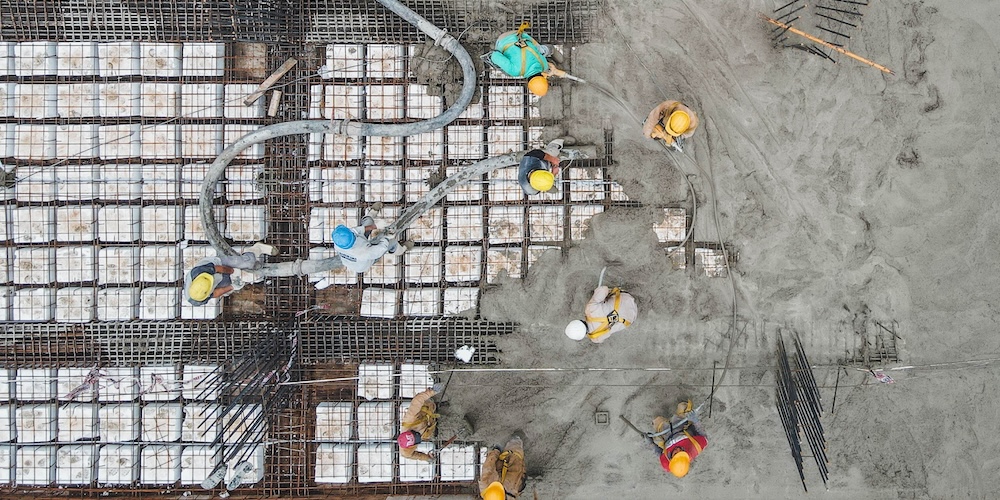— 8 min read
Construction Managers & General Contractors: Understanding the Differences
Last Updated Feb 22, 2024

There are several different stakeholders involved in the execution of construction projects. Sometimes, those roles interact, overlap or change depending on the owner or project characteristics. Two roles that may be confused are those of the general contractor (GC) and the construction manager (CM).
This article will discuss the similarities and differences between construction managers and general contractors and how to choose which is appropriate for which project.
Table of contents
General Contractors’ Role on Construction Projects
The general contractor is the person on the job who manages the actual construction work. The GC takes the design and concept that the owner and design team have created and makes it a reality. This role includes managing all aspects of a project, from planning the design’s execution to coordinating subcontractor work and materials procurement.
General contractors are hands-on with the daily progress of the project and take on a great deal of responsibility for its outcomes. They tend to have far more financial stake in the game than construction managers do.
Construction Managers’ Primary Project Duties
The project owner usually hires the construction manager early in the design process. The CM contributes to the design, as well as scheduling and procurement aspects of the project, offering the perspective of a construction professional to an owner not well-versed with the building process.
The CM then continues on throughout the project to watch over the work the general contractor is performing to ensure it adheres to the contract stipulations and the owner’s wishes. CMs are often brought in in a consulting capacity when owners don’t have the workforce or knowledge to ensure the project is following the right path. CMs know construction and become intimately familiar with the nuances of the contract to ensure that the GC is completing the job as expected.
Similarities Between GCs and CMs
In some cases, the general contractor and construction manager’s roles may look very similar. Depending on the project’s size and complexity, each sometimes interacts with the owner to ensure the project gets built out according to contract specifications. Here are some of the key similarities between the two roles:
| Design Approvals | The construction manager and the general contractor both need to sign off on designs before building begins. If the general contractor signs off on a certain design or suggests a change order, the design or the change order request would then go to the construction manager for approval before being passed on to the owner. The CM then needs to approve documents and activities before they go to the owner for approval. Because the CM is on site daily, they can confirm the legitimacy of the GC’s actions to the owner. |
| Project Oversight | Both the CM and the GC are experienced construction professionals, and both provide leadership within the project hierarchy. They both focus on the safety, efficiency and progress of the project to see it successfully carried out. |
| Quality Assurance | Construction managers and general contractors each play a role in quality verification engineering (QVE). After the GC has approved a section of work, a QVE, a third-party quality control professional, may check and approve it before passing it on to the CM. CMs may have their own team of inspectors who conduct site visits and become another layer of quality control. |
Design Approvals
The construction manager and the general contractor both need to sign off on designs before building begins. If the general contractor signs off on a certain design or suggests a change order, the design or the change order request would go to the construction manager for approval before being passed on to the owner. The CM then needs to approve documents and activities before they go to the owner for approval. Because the CM is on-site daily, they can confirm the legitimacy of the GC’s actions to the owner.
Project Oversight
Both the CM and the GC are experienced construction professionals providing leadership within the project hierarchy. They both focus on the project's safety, efficiency and progress to see it successfully carried out.
Quality Assurance
Construction managers and general contractors each play a role in quality verification engineering (QVE). After the GC has approved a section of work, the quality verification engineer, a third-party quality control professional, may do a check and approve it before passing it on to the CM. CMs may have their own team of inspectors who conduct site visits and become another layer of quality control.
Differences Between a CM and a GC
Since the CM and the GC are both involved in project oversight, quality assurance, and approvals, their roles may seem very close to the same thing. However, there are many key differences in the roles and responsibilities each takes on during a project.
CMs allow owners to be less involved.
The owner often hires the construction manager to be less involved in the daily operations of a construction project. The owner may not have the resources or the know-how to ensure everything stays on track. Without a CM, the owner needs to be comfortable managing the design process, understanding the contract, and following the project’s progress to ensure the GC is performing to specifications.
The CM may aid in labor and materials procurement.
A general contractor on a design-build or design-bid-build project receives a design and navigates purchasing materials and organizing labor for the job. The construction manager, acting as oversight to the general contractor, does not deal directly with materials procurement, although the CM may advise the owner on materials choices and procurement during the design phase.
CMs hold responsibility, but less risk.
A construction owner puts a lot of faith in the project manager on a job. The CM is on the site each day, taking notes of all activities and ensuring the project is moving along as expected. If the GC requests a change to the project scope that will impact the schedule or the budget, it’s up to the CM to validate the claim and decide whether the GC or the owner will be responsible for added costs.
However, the financial risks for these outcomes pass through the CM – either the GC or the owner, not the construction manager, will be responsible for added costs.
GCs and CMs are paid differently.
The GC gets paid from the profit of the work they do. They bid on a project and hope to spend less to complete the build than what the owner pays them to do the job, thus realizing a profit for the work.
A construction manager is hired by the project owner, and gets paid in billable hours, regardless of project outcomes.
What happens on a CM/GC or CMAR job?
On some projects, the general contractor also behaves like a construction manager, thus fulfilling both roles. In this case, the CM/GC takes on the design responsibilities of the CM and the project execution responsibilities of the GC.
However, a CM/GC project removes a layer of oversight between the GC and the owner, so owners may still hire a construction management firm on larger projects to ensure the GC is performing according to the contract.
When would an owner choose a GC or a CM?
Every project involves a GC, but it may only be larger or more complex jobs that bring in a construction manager as well. A job worth $1 million may lack the complexity of huge projects and span a short enough period not to involve a construction manager.
Large Projects
On some large public projects, the presence of a CM can help save general contractors the time it takes to keep all stakeholders apprised of project progress.
For instance, on a bridge project worth $3.6 billion that spans two states, there would be two state departments of transport and many interested parties that need to know what’s happening every step of the way. The CM could help take over some of the communication responsibilities so that the GC could remain focused on the jobsite.
Multiple Stakeholders
Too many project stakeholders asking questions and negotiating project details in back-and-forth conversations with GCs can slow up the work. Such a project would benefit from a construction management firm, which would follow the activities of the general contractor and report back to the owners, lenders, and investors.
Owner Resources
An owner’s decision on whether to hire a construction manager or leave the project to the general manager may come down to the resources available. If an owner has the staff or experience and expertise to keep an eye on the GC in-house, a CM may not be necessary.
How should an owner choose Between CM and GC?
One factor owners should consider when choosing whether or not to hire a construction manager is how heavily involved they want to be with the day-to-day activities on a project.
General contractors can successfully execute a build with or without a construction manager but are ultimately there to focus on the project, not the owner’s interests.
Construction managers offer a helpful buffer between the daily needs of a construction site and a busy owner – especially on large-scale projects. A construction manager may also offer knowledgeable insights into anything on the construction build, from the order of operations to contract clauses and beyond, and can provide another step to ensure quality assurance on the project work.
When deciding whether or not to hire a construction manager, or solely a general contractor for a particular project, owners should be well-informed about what the project will actually entail and decide whether they have the resources and industry experience to help carry it off without a CM’s support. They should also ensure that the contractor selected for the job is reliable and knowledgeable, and able to execute plans without heavy supervision.
Was this article helpful?
Thank you for your submission.
96%
4%
You voted that this article was . Was this a mistake? If so, change your vote here.
Scroll less, learn more about construction.
Subscribe to The Blueprint, Procore’s construction newsletter, to get content from industry experts delivered straight to your inbox.
By clicking this button, you agree to our Privacy Notice and Terms of Service.
Categories:
Tags:
Written by
Alex Six
13 articles
Alex Six is an Enterprise & Strategic Civil & Infrastructure Overlay Account Executive for Procore. Alex has a long background in the construction industry beginning with an internship with one of the biggest contractors in the world, and expanding across projects with teams as small as 4 people and as large as multi-billion dollar budgets with large teams and disciplines. His resume includes Caltrans highways & bridges, Metro light rail & underground, as well as airport runways and utilities.
View profileKristen Frisa
83 articles
Kristen Frisa is a contributing writer for Procore. She also contributes to a variety of industry publications as a freelance writer focused on finance and construction technology. Kristen holds a Bachelor of Arts in Philosophy and History from Western University, with a post-graduate certificate in journalism from Sheridan College. She lives in Ontario, Canada.
View profileExplore more helpful resources

Commercial Construction Management: Mastering the Basics
Commercial construction management is no small feat: Commercial projects tend to be large and complex, and unlike residential construction, which involves repeatable tasks, can involve industry-specific and technical aspects. Commercial...

Construction Manager vs. Project Manager: Comparing Leadership Roles
Skillful oversight of construction projects allows companies to deliver to owners on time and within budget. Construction managers (CMs) and project managers (PMs) provide the necessary supervision to keep projects...

Mastering Construction Resource Management: Strategies for Success
Completing construction projects successfully requires the careful management of various resources: labor, materials, equipment, money, time and information. Since these resources are finite, allocating them wisely is crucial for minimizing...

Managing Construction Projects in Different States: A Contractor’s Guide to Working Across State Lines
For many general contractors, taking on work in a new state or region can offer transformative opportunities for building a thriving business and a respected reputation. But managing projects is...
Free Tools
Calculators
Use our calculators to estimate the cost of construction materials for your next project.
Templates
Find a template to help you with your construction project tasks.
Material Price Tracker
Get the latest U.S. retail prices and view historical trends for common building materials.
Glossary
Explore key terms and phrases used in the industry.